History of Wisconsin State Fair
The Wisconsin State Fair has a rich history dating back to 1851 when the first State Fair was held in Janesville along the banks of the Rock River.
The State Fair has evolved over time to meet current trends, including large farm machinery displays in the late 1800s, aviation demonstrations in the early 1900s, the war efforts in the 1940s, hot entertainment acts since the 1950s, the space race in the 1960s, new and crazy food trends in recent years, and much more.
Read on below for a quick glance at the State Fair’s long history by the decade. For more information on annual attendance numbers, please visit our page on State Fair Attendance.
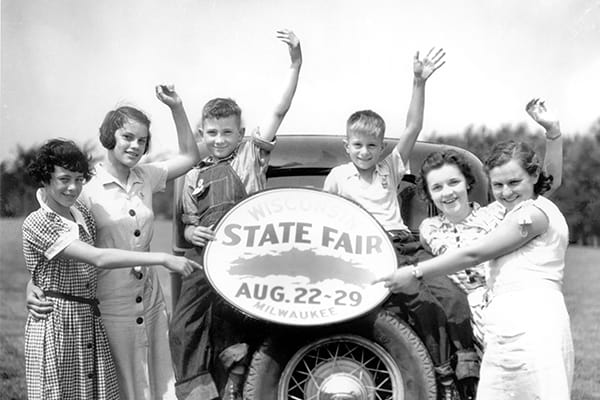
History Highlights
By the Decade
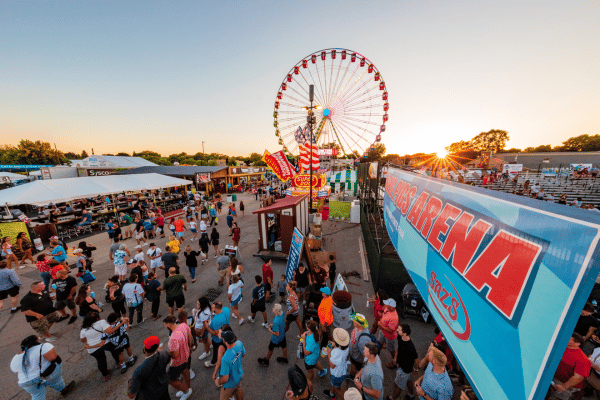
2020s
The start of the 2020s features exciting Fair Park renovations, the 100th year of the Cream Puff, and the one-year special of the Fair Food Drive-Thru. Despite obstacles the new decade brought, the State Fair continues to celebrate the best of Wisconsin!
Time of Year: Early August
Event Length: 11 days
Admission: $14 – $18
Notable Highlights:
2020 – The 2020 State Fair was canceled for the first time since 1945 due to the COVID-19 Pandemic. In this year, the innovative Fair Food Drive-Thru took place and flavored Cream Puffs were created.
2021 – The State Fair returns strong in 2021. Central Mall was renovated as a refreshed gathering destination with ample seating.
2022 – NASCAR returns to the Milwaukee Mile for the first time since 2009.
2023 – The first-ever Ag Discovery Day invites local students to interact with Wisconsin agriculture. The Fairtastic Art Poster Competition celebrates its 10th anniversary.
2024 – Original Cream Puff celebrates its 100th year and serves limit-edition flavors during the 2024 State Fair. INDYCAR returns to the Milwaukee Mile for the first time since 2015 for successful doubleheader races.
2025 – After 11 months of sweet renovations, The Dairy Building, formerly known as the Original Cream Puff Pavilion, has been restored to its original name and glory!
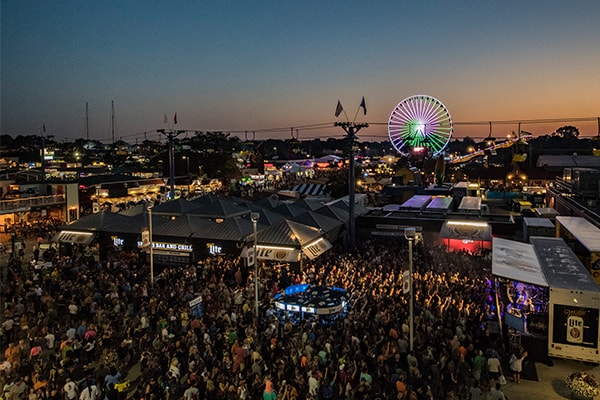
2010s
The 2010s featured new records for attendance, Cream Puffs, and the stunningly tall WonderFair Wheel. There was also a renewed focus to showcase the arts and the new foods got their own competition, The Sporkies.
Time of Year: Early August
Event Length: 11 days
Admission: $9 – $14
Notable Highlights:
2011 – The Guinness Book of World Records-certified largest Cream Puff is assembled at 7.5 inches tall by 38 inches wide and weighed a whopping 126 pounds.
2012 – The midway area is converted into SpinCity, an amusement area featuring independent rides and games run by the State Fair versus a travelling carnival.
2013 – Over one million fairgoers attended for the first time since the new 11-day format was introduced. First year for new favorites like the “Sporkies” new food competition and “Abso-Blooming-lutely” Garden Walk.
2014 – The Fairtastic Art Poster Competition debuted as a commemorative annual art program.
2015 – Nick Wallenda performed on a high wire act walking over the Milwaukee Mile in a record-breaking walk above the racetrack. First Annual Plein Air at the Fair contest challenged artists to capture real-time scenes of the State Fair on canvas.
2017 – North America’s largest traveling Ferris wheel, the WonderFair Wheel, was a massive hit offering ultra-high views of the State Fair and surrounding city. The introduction of the All for One Swine Show encouraged and allowed the showing of pigs by youth with intellectual disabilities.
2019 – A record-breaking total attendance for the modern era included five days reaching new highs.
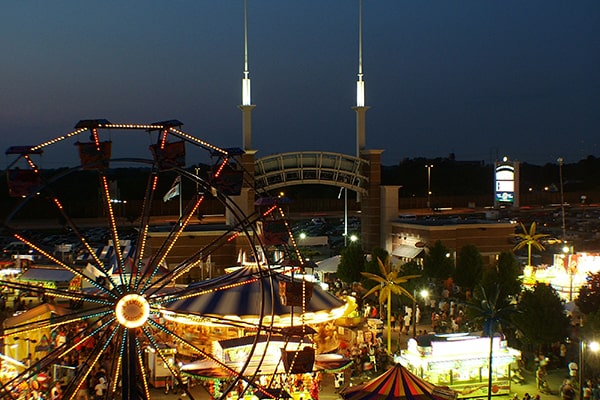
2000s
Building for future generations. Food became an ever-larger attraction for fairgoers as the decade went on.
Time of Year: Early August
Event Length: 11 days
Admission: $6 – $9
Notable Highlights:
2000 – A new Main Gate was built on the north end of State Fair Park marking the entrance to the new home of the midway, a new pedestrian gate on the southeast corner at Greenfield Avenue & 84th Street provided easy-access, and the 1907 Dairy Cattle barn received much-needed renovations. The Trade Mart was converted into the Wisconsin Products Pavilion featuring Wisconsin agriculture commodity groups and Wisconsin food companies.
2001 – Stock car and circus shows were massive hits during the State Fair.
2003 – New construction included a new bi-level livestock barn with a new milking parlor and a new grandstand. First year of the Crazy Grazin’ Day that offered smaller portions for smaller prices. Grandstand acts included Kelly Clarkson and Brad Paisley.
2004 – The Cream Puff celebrated its 80th birthday and the Wisconsin Baker’s Association introduced the Blue Ribbon Brownie.
2009 – Foods on-a-stick like chocolate-covered bacon on-a-stick, fried peanut butter and jelly on-a-stick, cherry pie on-a-stick, mini burgers on-a-stick, and cookie dough on-a-stick were all the rage.
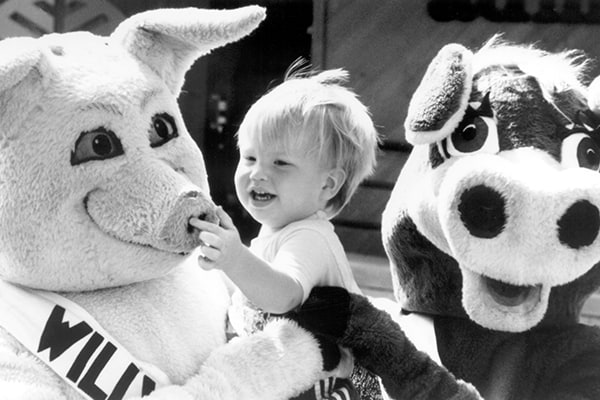
1990s
The Centennial Celebration of State Fair Park was the highlight of the decade, which laid the groundwork for the next millennium.
Time of Year: Early August
Event Length: 11 days
Admission: $4 – $6
Notable Highlights:
1992 – 100-year celebration at the current location featured a time capsule and special merchandise. Grandstand entertainment featured Huey Lewis and the News, Billy Ray Cyrus, the Statler Bros, the Beach Boys, Alabama, Garth Brooks, World Championship Wrestling, and professional boxing.
1995 – Newly installed baking facilities in the Dairy Building allowed for lines to move faster and over 250,000 cream puffs to be sold.
1998 – A 130-foot platform let visitors try bungee jumping. The Great Moo-Off contest for young fairgoers rewarded the best bovine impersonations.
1999 – For the first time, Cream Puffs were available for pick-up by the dozen via a drive-thru during the State Fair.
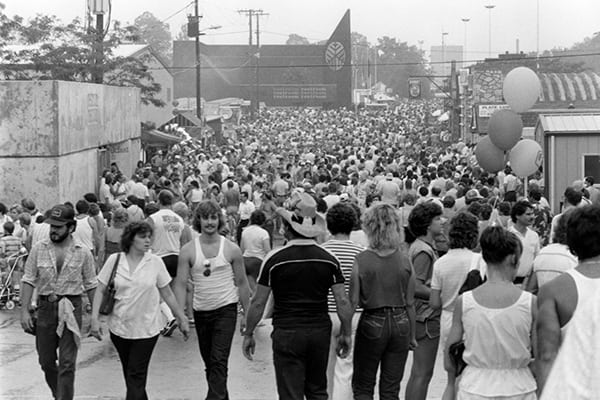
1980s
The 1980s were known for animal puns, State Fair mascots, and super-sized food items.
Time of Year: Early August
Event Length: 11 days
Admission: $2 – $4
Notable Highlights:
1980 – Fairgoers were asked to submit agricultural puns and imagery which would make up much of the decades’ fliers and billboards that received national attention. Popular campaigns included Check Out The Chicks, Check Out Our Dairy Heirs, Still Crazy After All These Ears, and Days of Swine & Roses.
1981 – The opening ceremony introduce a new mascot named Willy B. Bacon who promoted the State Fair with Violet the Cow.
1983 – The first State Fair Stampede was held, with other events including the World Thumb Wrestling Championship, prettiest legs contest, senior dance contest, donkey races, and the World’s Largest Schaum Torte.
1984 – The World’s Largest Baked Alaska. The first Governor’s Cheese and Butter Auction was held with proceeds benefitting dairy research.
1986 – The racing pigs made their first debut as they competed for cookies at the finish line.
1989 – The Belle of Wisconsin, a 40,000-pound block of cheddar, concluded its nationwide promotional tour at the State Fair.
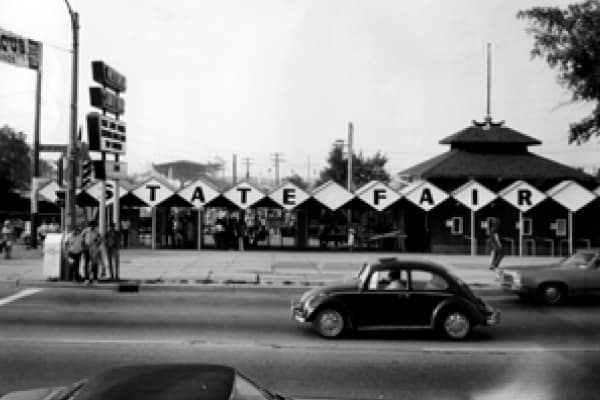
1970s
This decade featured improvements from the grounds, buildings, and even a new logo.
Time of Year: August
Event Length: 10-11 days (the current 11-day State Fair started in 1975)
Admission: $2 – $2.50
Notable Highlights:
1970 – The Central Park area was reinvigorated featuring ice cream concessions and entertainment.
1972 – The iconic snowflake logo was created to symbolize the year-round use of State Fair Park.
1974 – Construction projects for the year included a 1,000-seat amphitheater, a milking parlor addition to the dairy barn, and the East, South, and North Exhibit Halls were connected with a lobby to form one large building.
1975 – The first Amateur Vintner’s contest was held. Grandstand shows featured Three Dog Night, The Spinners, Bobby Vinton, Tanya Tucker, and The Osmonds.
1976 – A new award-winning Coliseum debuted for livestock judging and a modern Journal News Center was built.
1979 – New construction projects included a Horse Barn and Sheep Barn, and improvements to agricultural buildings and Activity Area. Grandstand entertainers included Pablo Cruise, George Benson, K.C. & the Sunshine Band, Willie Nelson, and auto races.
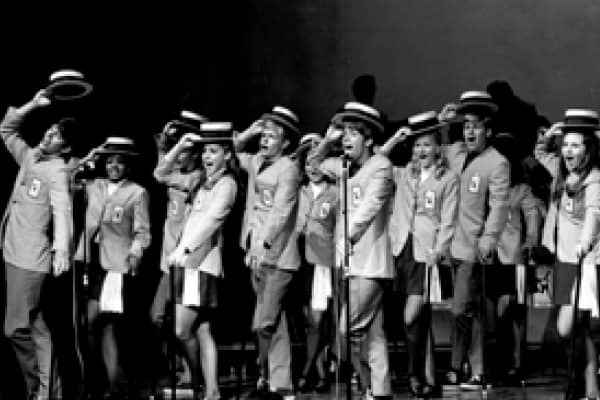
1960s
The focus for this decade was automobile racing and grandstand entertainment.
Time of Year: Mid-August
Event Length: 10 days
Admission: $0.75 – $1.50
Notable Highlights:
1960 – A variety show featured the Lennon Sisters and Three Stooges, and the Pat Boone Show performed seven times.
1961 – Grandstand featured fifteen Roy Rogers shows and four auto races. The permanent Midway was removed and workers found the aquarium built in 1910 encased within one of the structures.
1963 – The Space Race was brought to the State Fair with features such as a Jet Man Rocket Belt demonstration, a Moon Base Exhibit, and space lectures.
1968 – Grandstand performances included Johnny Carson, Doc Severinsen, the American Folk Ballet, Mike Douglas, Don Adams, James Darren, the Statler Brothers, the Cowsills and USAC races.
1969 – The Kids from Wisconsin performed for the first time with their broadway-style act. The Grandstand offered free performances by Liberace, Diana Ross and the Supremes, Johnny Cash, and Bob Barker.
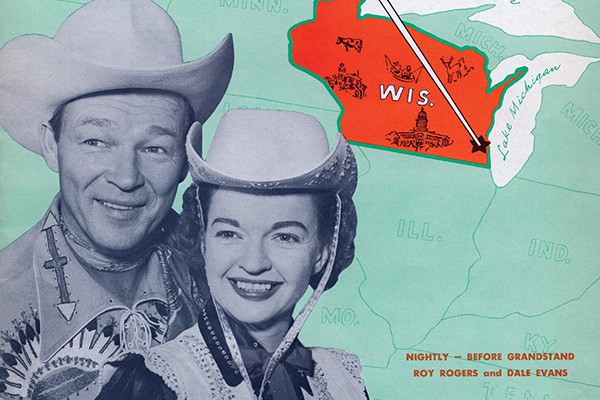
1950s
In the 1950s, entertainment became an even larger focus.
Time of Year: Late August
Event Length: 9-10 days
Admission: $0.50 – $0.75
Notable Highlights:
1951 – The Wisconsin At Work Building featured an atomic energy exhibit.
1952 – Replicas of ancient Roman chariots raced on the track over four days. Fifth Army Troops staged a mock battle before the Grandstand each morning.
1954 – The Milwaukee Mile Speedway was paved with asphalt while new dirt tracks were made inside the oval outer track. One of the concessions stands featured “all-the-milk-you-can-drink-for-10¢.”
1955 – The polio epidemic resulted in lower attendance. A Wild Animal Show, Hopalong Cassidy, and a western horse show were just a handful of entertaining events.
1958 – Roy Rogers’ and Dale Evans’ grandstand shows were some of the most popular acts of all time.
1959 – Tennessee Ernie Ford, US Auto Club (USAC) Races, the Ringling Brothers, and Barnum & Bailey Circus shows entertained the grandstand crowds.
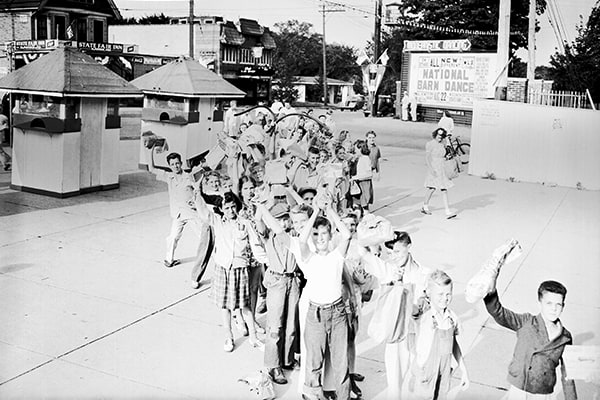
1940s
World War II and Wisconsin’s Centennial Celebration were the focus for this decade.
Time of Year: Mid-August
Event Length: 7-23 days
Admission: $0.25 – $0.50
Notable Highlights:
1940 – Opening Day was called Aviation and Defense Day, where 75 planes flew in formation over the State Fair Park.
1942 – A single day attendance record of 124,783 was set. The theme was “Food for Victory,” focusing each department on wartime production and conservation efforts.
1943 – War stamps or bonds served as admission, and children were admitted free with one-half pound of copper, three pounds of paper, or two pounds of steel or iron.
1945 – The Office of War Transportation requested the State Fair be canceled.
1946 – The first official statewide welcome home for veterans in the country was held on opening day of the State Fair.
1948 – The State of Wisconsin celebrated its 100-year anniversary! The entire State Fair Park was renovated for the 23-day celebration. The Grandstand’s “Show of A Century” included song, dance, acrobatics, and a water ballet. First year for the Alice in Dairyland program, which featured a large mechanical mannequin of Alice that spoke to children. The Century Farm and Home program began honoring continuous ownership within the same family for 100 years or more. The World Premiere of the play “Paul Bunyan” was performed at the Grandstand.
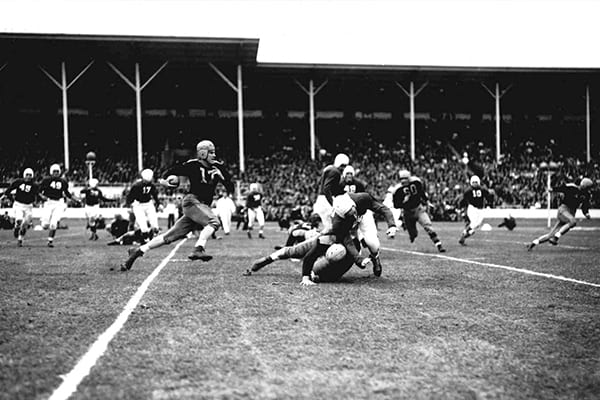
1930s
This decade’s signature feature was football at State Fair Park.
Time of Year: Late August
Event Length: 6-9 days
Admission: $0.25 (1933-1939) – $0.50 (1930-1932)
Notable Highlights:
1931 – The Great Depression caused the State Fair to lower premiums and cut the annual budget.
1932 – Mille’s Italian Sausage is the first permanent food stand built at State Fair Park. Rides on the World’s Fair Blimp carried passengers from State Fair Park to Milwaukee’s lakefront.
1934 – Green Bay Packers played for the first time on the infield of the Milwaukee Mile.
1936 – Celebration of Wisconsin’s Territorial Centennial anniversary.
1939 – On December 11, more than 32,000 spectators witnessed the seventh NFL championship played in front of the Grandstand.
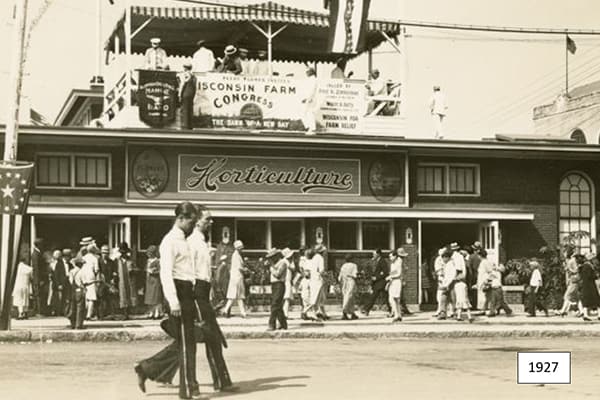
1920s
This decade focused on fun and tasty traditions at the State Fair!
Time of Year: Late August
Event Length: 6 days
Admission: $0.50
Notable Highlights:
1920 – The State Fair held its first night horse show. An Aviation Derby featured a 300-mile airplane race that started and finished at the State Fair.
1921 – A permanent amusement park began with the construction of the Old Mill, a popular “tunnel-of-love” ride.
1922 – American automobile-maker Henry Ford visited the State Fair.
1923 – Fun City was created when 64 new amusement park concessions and rides were installed around the existing Old Mill.
1924 – The famous cream puff made its first appearance in the Dairy Building.
1926 – Colonel Theodore Roosevelt Jr., eldest son of former U.S. President Theodore Roosevelt, delivered a speech about his recent African safari.
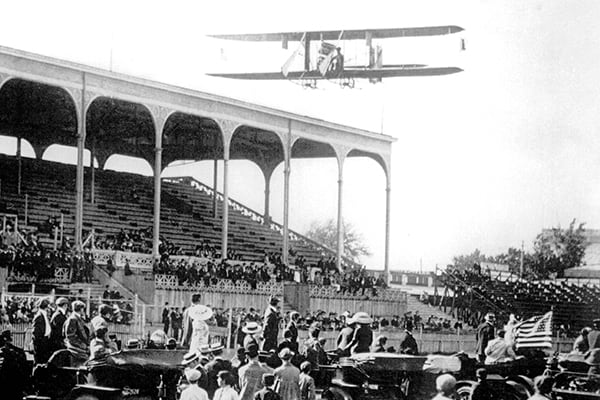
1910s
This decade was all about transportation: air, automobiles, motorcycles, and more.
Time of Year: Mid-September
Event Length: 5-6 days
Admission: $0.50
Notable Highlights:
1910 – Airship race and motorcycle races held in the Grandstand. Grand Champion Hall constructed (formerly known as the Horticulture or Flower Building) and is the third oldest building at State Fair Park. A 30-window aquarium was built to house fish from Wisconsin waters.
1911 – Aviator Lincoln Beachey took off from State Fair Park and made the first airplane flight over Milwaukee.
1913 – Entertainment included a Wild West Show, auto races, and auto polo matches. Moving pictures (video) were taken at the State Fair for the first time.
1915 – A new grandstand was constructed. The first automobile exhibit was shown, and horseshoeing and model airplane competitions were held.
1919 – The first passenger airplane constructed in the U.S., “the Lawson Airliner”, was built in one of the exhibit halls. Grandstand performances included a diving act, boxing kangaroos, acrobats, aviator Louis Gertson, and Persian athletes.
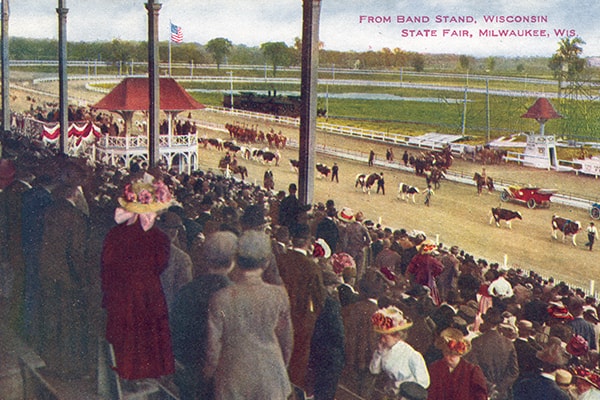
1900s
During this decade many improvements were made to the grounds including new buildings, electricity, and bigger-than-life entertainment.
Time of Year: Mid-September
Event Length: 6 days
Admission: $0.50
Notable Highlights:
1901 – Locomotive collision was the main grandstand entertainment; new dairy barn and new photo division was added.
1903 – First automobile race held on dirt track.
1904 – Electric lighting allowed for the State Fair to continue into the night.
1905 – A fireworks display and the Pacific Borax Company 20-mule team and wagon thrilled fairgoers.
1907 – Dairy Cattle Barn was built (oldest building at State Fair Park today). First State Fair Police organized.
1908 – Horse relay and chariot races entertained crowds at the Grandstand.
1909 – The Original Cream Puff Pavilion (formerly known as the Dairy Building) was built for $35,000 and is the second oldest building at State Fair Park. A sculpture of U.S. President Taft was created in butter.
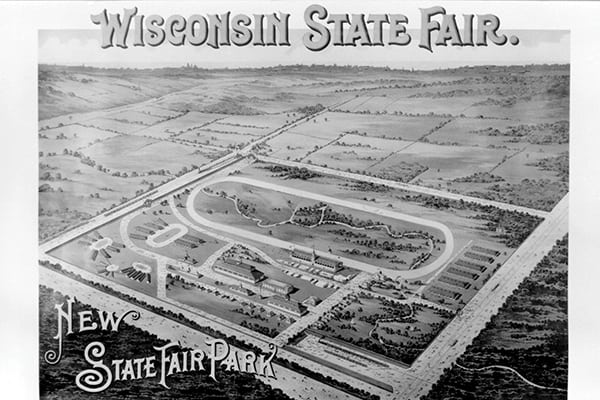
1890s
State Fair locations this decade included Milwaukee’s Cold Spring Race Course (1890-1891) before settling at State Fair Park in West Allis in 1892. The new State Fair Park was the crowning event during the decade.
Time of Year: September
Event Length: 5-6 days
Admission: $0.50
Notable Highlights:
1891 – The Agricultural Society purchased the 160-acre Steven’s Farm for $136,000 as a permanent site for the State Fair. Criteria for selecting the new site included a size of at least 100 acres, located within a ten-mile radius of the Milwaukee County Courthouse, and must cost $150,000 or less.
1892 – First year at the new State Fair Park. The new facility featured a 6,000-seat grandstand, racetrack, and exhibit buildings. Attendance for the six-day fair was 60,000 guests.
1893 – The State Fair was canceled due to the concern that the World’s Columbian Exposition in Chicago would lower attendance.
1895 – A football match was held between University of Wisconsin and Northwestern University for the title “Champion of the West.”
1896 – First dog show, record livestock entries, and the largest swine show at any American fair.
1898 – Fairgrounds were temporarily renamed Camp Harvey in spring and used for training Wisconsin National Guard soldiers during the Spanish-American War.
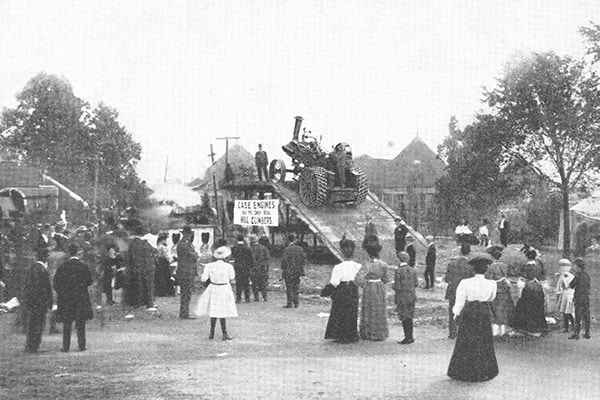
1880s
State Fair locations this decade moved from Madison’s Camp Randall (1880, 1883-1885), Fond du Lac (1881-1882), and Milwaukee’s Cold Spring Race Course (1886-1889).
Farm machinery displays thrived during this decade with over 100 products displayed from 20 different companies.
Time of Year: September
Event Length: 5-6 days
Admission: $0.50
Notable Highlights:
1880 – Former U.S. President Ulysses S. Grant delivered an address congratulating the people of Wisconsin on “their wealth and prosperity.”
1884 – The farm machinery show was considered “outstanding!”
1885 – With the largest number of entries ever, the State Fair was considered the best held east of the Mississippi.
1887 – More than 200 sheep and 300 poultry entries caused officials to add a limit to the number of entries.
1889 – The first Women’s Work show was held. Increased demand to find a permanent site for the State Fair.
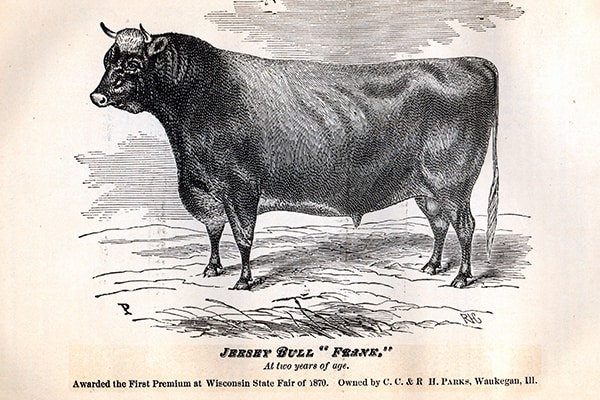
1870s
State Fair locations in this decade moved between Milwaukee’s Cold Spring Race Course (1870-1876), Janesville (1877), and Madison’s Camp Randall (1878-1879).
Agriculture was in the forefront during this decade.
Time of Year: September
Event Length: 4-10 days
Admission: $0.50
Notable Highlights:
1871 – Entries reached a high of 2,097 livestock.
1873 – First year of Holstein cattle judging. Milwaukee’s mayor requested that stores and schools close for one afternoon so that citizens could visit the State Fair.
1876 – The State Fair was extended to ten days in celebration of the nation’s centennial anniversary.
1877 – The Swine Department had a record with 700 entries.
1878 – U.S. President Rutherford B. Hayes spoke on “growing out of five years of hard times.” Mrs. Hayes was reported to be the “idol of the populace.”
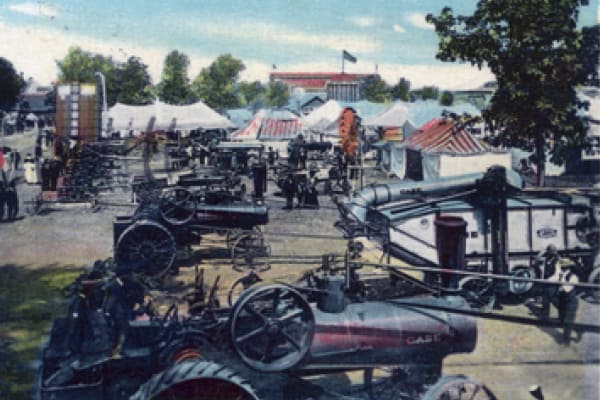
1860s
State Fair locations in this decade included Madison’s Camp Randall (1860, 1867-1869) and Janesville (1864-1866).
Farm machinery exhibits became a major attraction for the State Fair during this decade.
Time of Year: Late September to Early October
Event Length: 4-5 days
Admission: $0.25
Notable Highlights:
1860 – Naturalist John Muir from Montello, age 22, displayed several of his inventions.
1861-1863 – The State Fair was canceled in for three years due to the American Civil War. During those years, the fairgrounds leased in Madison were used as a training camp for troops, which is how it got the name Camp Randall.
1864 – Manufacturers’ Hall showcased cooking stoves and distributed samples of roast beef and bread.
1865 – Popular entertainment included horse racing speed trials.
1868 – 20-horsepower steam engine on display to demonstrate agriculture machinery in action. First year of the Brown Swiss cattle judging.
1869 – A demonstration of fire engines was held where boxes, barrels, and a large wooden building were set afire and the blazes were put out using the fire engines.
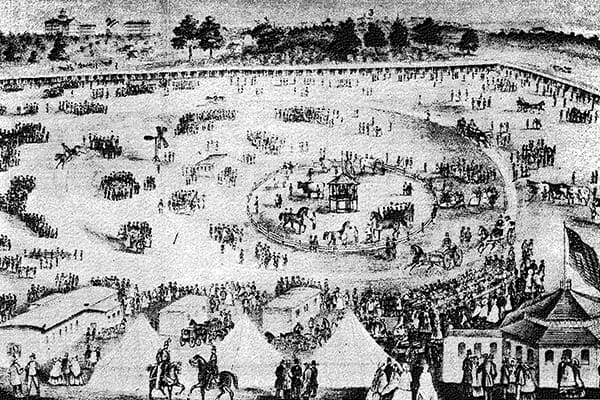
1850s
The first Wisconsin State Fair was held along the banks of Rock River in Janesville. In its early years, the State Fair moved locations annually, and was hosted in Janesville (1851, 1857), Milwaukee’s Cold Spring Race Course (1852, 1856), Watertown (1853), Milwaukee’s Spring Street Grounds (1854-1855, 1859), and Madison’s Bruen Estate (1858).
Agriculture was the main feature in the first decade. The State Fair was the largest reported gathering at any Wisconsin event held up to that date (1851).
Time of Year: Early October
Event Length: 2-4 days
Admission: $0.10 – $0.25
Notable Highlights:
1851 – Popular features included a 200-pound squash and a quarter-acre plowing competition with teams of horses and oxen.
1854 – The Agricultural Society Officers began to talk about a permanent fairgrounds.
1856 – A farm implement display showed beginnings of mechanized farming and Wisconsin Manufactured Goods.
1857 – 600-pound cheese on display.
1859 – Illinois lawyer and future U.S. President Abraham Lincoln addressed fairgoers on agriculture.
State Fair History Archives
The historical archives of the Wisconsin State Fair are managed by the staff of Wisconsin State Fair Park. A huge thank you to former historians Jerry Zimmerman and Richard Ziervogel for spearheading the historical research and collecting of historically significant materials.
If you care to contribute any authentic, historical materials about Wisconsin State Fair or State Fair Park such as photos (original or copies), news articles, programs, etc., please send physical items to Wisconsin State Fair Park, Attn: Historical Archives, 640 S. 84th Street, West Allis WI 53214 or digital items to wsfp@wistatefair.com.
